|
Orthologix brings you quarterly information to keep you current on industry news, trends and insights. Orthologix is an orthotics and prosthetics practice delivering evidence-based care throughout the Delaware Valley.

Featured Product
Pediatric Prostheses
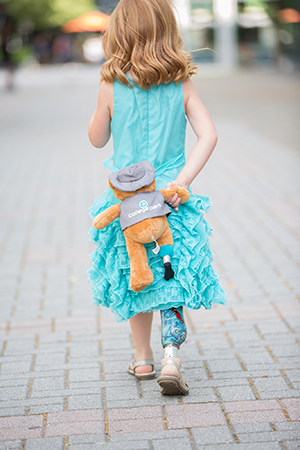 The prosthetic needs of pediatric patients require the skill and expertise of practitioners who are knowledgeable about the factors unique to that age group. A pediatric patient is constantly growing and developing so practitioners must constantly evaluate and adjust the prosthesis to accommodate the ever-changing child. The prosthetic needs of pediatric patients require the skill and expertise of practitioners who are knowledgeable about the factors unique to that age group. A pediatric patient is constantly growing and developing so practitioners must constantly evaluate and adjust the prosthesis to accommodate the ever-changing child.
There are many options to help patients with lower limb loss; Össur is one of the larger providers of pediatric prostheses.
Feet
Footwear is chosen to match a child’s activity level. Health, height and weight, level of amputation, and the length and shape of the residual limb are considerations when selecting the appropriate foot. Multi-axial feet allow the foot to move up and down and bend side to side for walking on uneven surfaces. Energy-storing or dynamic response feet provide a sense of push-off, a more normal range of motion, and balanced gait.
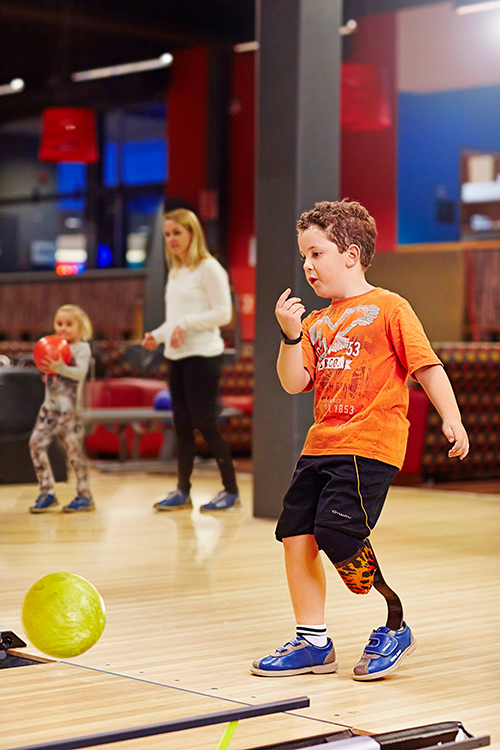 Össur Flex-Run™ Junior: Its vertical compliance and efficient energy return are must haves for highly active children. Designed to be the most flexible of the running feet, the Flex-Run Junior offers increased cushioning and lower-frequency dynamic makes this foot ideal for transfemoral and transtibial users. The Nike sole is designed to offer increased stability and smooth natural rollover. Össur Flex-Run™ Junior: Its vertical compliance and efficient energy return are must haves for highly active children. Designed to be the most flexible of the running feet, the Flex-Run Junior offers increased cushioning and lower-frequency dynamic makes this foot ideal for transfemoral and transtibial users. The Nike sole is designed to offer increased stability and smooth natural rollover.
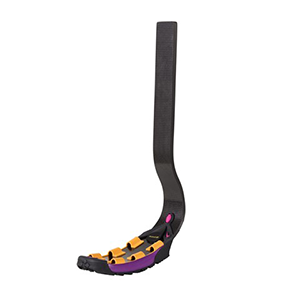 Össur Cheetah® Junior: Custom-built, high-performance carbon fiber foot designed primarily for sporting activities. This is the optimal run and play foot for both transtibial and transfemoral users. It attaches posterior to the socket, making it agile, strong and a proven performer for those children who want to practice sports. The Nike sole is designed to offer increased stability and smooth natural rollover. Össur Cheetah® Junior: Custom-built, high-performance carbon fiber foot designed primarily for sporting activities. This is the optimal run and play foot for both transtibial and transfemoral users. It attaches posterior to the socket, making it agile, strong and a proven performer for those children who want to practice sports. The Nike sole is designed to offer increased stability and smooth natural rollover.
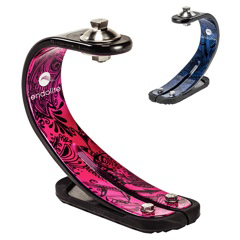 Endolite Mini BladeXT: For youngsters, life never stops. An active lifestyle needs to be fully equipped to meet the needs of the most demanding user, whether it’s going to school, spending time with friends, running, cycling or taking part in other sports. Designed to offer a complete solution, the Mini BladeXT offers outstanding stability, ground compliance and improved comfort through the split toe and traction sole, while its C-shaped toe spring is primed for optimal energy response. Endolite Mini BladeXT: For youngsters, life never stops. An active lifestyle needs to be fully equipped to meet the needs of the most demanding user, whether it’s going to school, spending time with friends, running, cycling or taking part in other sports. Designed to offer a complete solution, the Mini BladeXT offers outstanding stability, ground compliance and improved comfort through the split toe and traction sole, while its C-shaped toe spring is primed for optimal energy response.
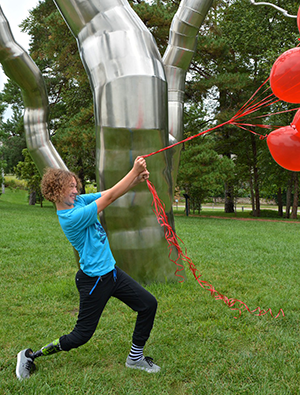 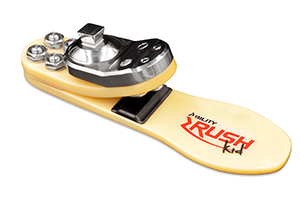 RUSH Kid™: Built kid tough, the RUSH Kid foot can handle running, jumping, and playing of active kids in mud, water, and sand. Its ultra-low profile build delivers dynamic energy return and smooth roll-through. RUSH Kid™: Built kid tough, the RUSH Kid foot can handle running, jumping, and playing of active kids in mud, water, and sand. Its ultra-low profile build delivers dynamic energy return and smooth roll-through.
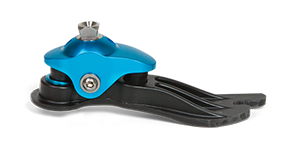 College Park’s TruPer®: The TruPer foot is a multi-axial, dynamic-response foot and can be fitted to children as young as 3 years old. The TruPer also incorporates a foot shell with a split toe so children can wear shoes and sandals of their choice. College Park’s TruPer®: The TruPer foot is a multi-axial, dynamic-response foot and can be fitted to children as young as 3 years old. The TruPer also incorporates a foot shell with a split toe so children can wear shoes and sandals of their choice.
Knees
For transfemoral amputees, the proper choice of a knee is vital for achieving mobility, function, and confidence. Knees must provide reliable support when standing, allow smooth, controlled motion when walking, and permit unrestricted movement for sitting, bending, and kneeling.
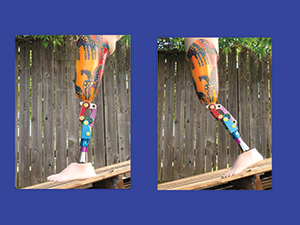 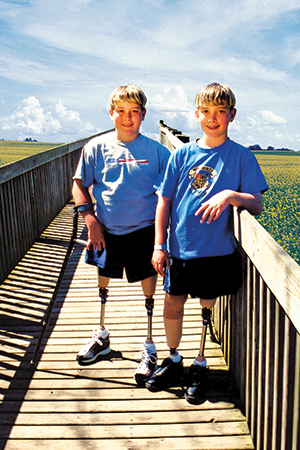 Össur Total Knee® Junior: Made of lightweight, extremely durable aluminum, and weighs only 0.745 lb. The inventor was Finn Gramnas, who was inspired by his six-year-old daughter struggling to walk without falling while wearing a heavy and clumsy prosthesis. He invented the geometric locking system that offers extra security and stability, even on hills, which is achieved through the knee’s seven-axis polyaxial design for children weighing up to 100 lbs. Össur Total Knee® Junior: Made of lightweight, extremely durable aluminum, and weighs only 0.745 lb. The inventor was Finn Gramnas, who was inspired by his six-year-old daughter struggling to walk without falling while wearing a heavy and clumsy prosthesis. He invented the geometric locking system that offers extra security and stability, even on hills, which is achieved through the knee’s seven-axis polyaxial design for children weighing up to 100 lbs.
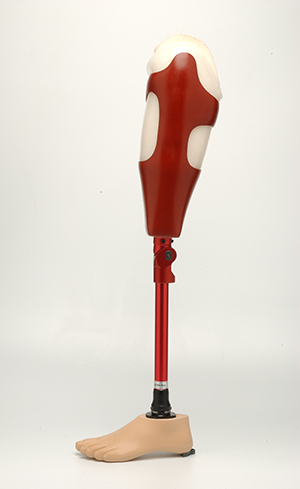 Ottobock 3R38: The 3R38 is the smallest single axis children’s modular knee joint. It has an adjustable extension assist to provide additional security and an internal spring mechanism helps swing the lower part of the leg forward when the child takes a step for children weighing up to 99 lbs. Ottobock 3R38: The 3R38 is the smallest single axis children’s modular knee joint. It has an adjustable extension assist to provide additional security and an internal spring mechanism helps swing the lower part of the leg forward when the child takes a step for children weighing up to 99 lbs.
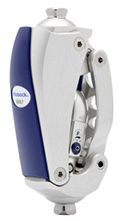 Ottobock 3R67: The cutting-edge technology of the new 3R67 prosthetic knee joint meets the everyday demands of children, ages six through twelve, during a myriad of playtime activities. These activities include different walking and running speeds, intuitive kneeling with a flexion angle of up to 150 degrees, and frequent changes of pace while riding a bike or scooter. Thanks to the integrated hydraulics, the prosthetic knee joint functions smoothly in the swing phase. The polycentric four-axis geometry of the joint ensures a high level of stance phase stability and safety. With these features, the 3R67 provides young users with reliable support at any walking speed and enables spontaneous actions. In addition, the prosthesis can be extended as the child grows. With a net weight of just 18 ounces (510 g), the joint offers great freedom of movement. Ottobock 3R67: The cutting-edge technology of the new 3R67 prosthetic knee joint meets the everyday demands of children, ages six through twelve, during a myriad of playtime activities. These activities include different walking and running speeds, intuitive kneeling with a flexion angle of up to 150 degrees, and frequent changes of pace while riding a bike or scooter. Thanks to the integrated hydraulics, the prosthetic knee joint functions smoothly in the swing phase. The polycentric four-axis geometry of the joint ensures a high level of stance phase stability and safety. With these features, the 3R67 provides young users with reliable support at any walking speed and enables spontaneous actions. In addition, the prosthesis can be extended as the child grows. With a net weight of just 18 ounces (510 g), the joint offers great freedom of movement.
 Ottobock 3S80=1: Especially for running sports, the fitness knee provides faster flexion and extension for dynamic response to changing running pace. It benefits children who generate less force when flexing the knee. It also has a manual lock for standing as well as warm-up and stretching exercises, which the user can engage/disengage quickly. Ottobock 3S80=1: Especially for running sports, the fitness knee provides faster flexion and extension for dynamic response to changing running pace. It benefits children who generate less force when flexing the knee. It also has a manual lock for standing as well as warm-up and stretching exercises, which the user can engage/disengage quickly.
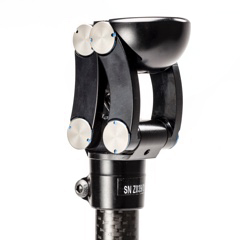 Endolite Child’s 4-bar Knee: It is a durable, lightweight and low maintenance knee designed for energetic children. It features a polycentric design for stability during stance and an adjustable extension assist spring to provide swing control. Endolite Child’s 4-bar Knee: It is a durable, lightweight and low maintenance knee designed for energetic children. It features a polycentric design for stability during stance and an adjustable extension assist spring to provide swing control.
Back to top

CASE STUDY
Össur clinical studies on the effects of providing pediatric patients a functional prosthesis.
DYNAMICS OF BELOW-KNEE CHILD AMPUTEE GAIT: SACH FOOT VERSUS FLEX-FOOT. K. Schneider, T. J. Hart, R. F. Zernicke, Y. Setoguchi, W.Oppenheim
Abstract: Gait kinematics and dynamics during stance of unilateral, below-knee child amputees were analyzed for self-selected, comfortable (0.9 m s−1) and fast (1.3 m s−1) speeds with the SACH foot and the energy-storing Flex-foot prostheses. The three-dimensional movements of the lower limbs were recorded and synchronized with ground reaction forces for 12 subjects (7 girls and 5 boys, ages 6–16 yr). Each lower limb was modeled as a set of interconnected rigid links (thigh, leg, and foot) with frictionless joints (hip, knee, and ankle) to calculate moment and joint power profiles. Marked asymmetries were noted in ground reaction force, joint moment, and power profiles for the prosthetic versus the natural limb, but with the Flex foot the asymmetries were less pronounced than with the SACH foot. For the amputee wearing the Flex foot, greater moments and power were generated by the natural limb at the comfortable pace as compared to the SACH foot, but during fast walking, the SACH foot required greater output from the natural limb. With both prostheses, for the prosthetic limb the amputees used similar force, moment, and power patterns, but with significantly different amplitudes. At both speeds of walking, the Flex foot returned significantly more energy (66 % at comfortable and 70 % at fast walking) than the SACH foot (21 % at comfortable and 19 % at fast walking). Thus, the Flex foot had a greater potential for reducing the energy cost of walking at comfortable and fast speeds for the below-knee child amputee. For more information: click here
BELOW-KNEE CHILD AMPUTEE GAIT: DYNAMICS OF AN ENERGY-STORING PROSTHESIS. T.J. Hart, K. Schneider, R.F. Zernicke, Y. Setoguchi, W. Oppenheim
For the young child, stable and independent gait represents a significant milestone in motor skill development. The ability to locomote freely requires careful coordination of many body segments. For the child with amputation, the development of walking is more challenging, as the child must adopt movement strategies to compensate for the residual limb and prosthesis. With the development of “energy-storing” prostheses, the conventional functional requirements of prosthetics are being reassessed, but few studies have examined the benefits of this new generation of prosthesis, and no investigation to date has addressed their benefits for children. Thus, the current study described the kinematic and kinetic profiles of below-knee amputee children as they walked at normal and fast speeds wearing either a conventional prosthetic foot (SACH) or an energy-storing foot (Flex-Foot). Kinematic and kinetic performance profiles were analyzed for twelve below-knee (BK) amputee children. Motion data were synchronized with ground reaction forces to quantify the strategies used by the BK children to compensate for the partial loss of the lower extremity and to differentiate between the SACH foot and the Flex-Foot. Kinematic and kinetic parameters measured during the stance phase of gait included joint ranges of motion, peak ground reaction forces and center of pressure, joint muscle moments, and joint power and energy. The results indicated that the Flex-Foot absorbed and generated significantly more energy than the SACH foot. The Flex-Foot had greater potential for reducing the energy cost of walking for the BK child by providing a significant push-off force and thus compensated for decreased hip flexor moment at toe-off. Significant asymmetries were noted in the force, moment and power profiles of the prosthetic limb as compared to the natural limb. Although the natural limb was primarily responsible for maintaining stable gait, the capabilities of the Flex-Foot decreased the demands on the natural limb. Supported in part by a grant from Shriners Hospital for Crippled Children (15952). For more information: click here.
NORMATIVE GROUND REACTION FORCE DATA FOR ABLE-BODIED AND TRANS-TIBIAL AMPUTEE CHILDREN DURING RUNNING. J.R. Engsberg, A.G. Lee, K.G. Tedford, and J.A. Harder
Abstract: The purpose of this investigation was to develop normative ground reaction force data for able-bodied (AB) and trans-tibial amputee (TTA) children during running. Two hundred AB (mean age 9.4 years, range 7-12) and 21 TTA (mean age 11.1 years, range 5-17) children ran (2.2 m/s +/- 10%) over a force platform. Ground reaction force data were normalized, averaged within groups and plotted to produce force-time curves characterizing the different leg types (i.e. able-bodied, non-prosthetic and prosthetic). In addition, discrete variables characterizing the leg type differences were determined. One way ANOVA determined significant differences between variables and a Tukey Post Hoc analysis defined which variables were significantly different (p < 0.05). Results generally indicated differences between the three leg types with the non-prosthetic leg indicating greater forces than the prosthetic and AB legs. The results of this investigation provide normative ground reaction force data for both AB and TTA children during running and can be used for comparison with other groups of children. Read more.

PROFILE
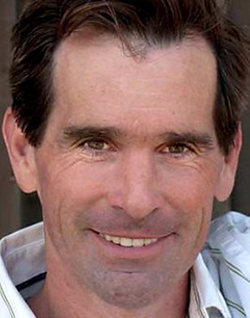 The inventor of the Flex-Foot, Van Phillips, turned a tragic moment into a revolutionary business that has helped thousands around the world lead more normal, active lives. The Flex-Foot is a high-performance carbon composite prosthetic foot, designed to store and release energy in order to mimic the reaction of the human anatomical foot/ankle joint. Phillips, who holds approximately 100 U.S. and international patents, made it possible for amputees to participate in sports such as running, skiing, climbing and hiking. The inventor of the Flex-Foot, Van Phillips, turned a tragic moment into a revolutionary business that has helped thousands around the world lead more normal, active lives. The Flex-Foot is a high-performance carbon composite prosthetic foot, designed to store and release energy in order to mimic the reaction of the human anatomical foot/ankle joint. Phillips, who holds approximately 100 U.S. and international patents, made it possible for amputees to participate in sports such as running, skiing, climbing and hiking.
The journey began when Phillips was 21 and a student at Arizona State University. A water skiing accident in 1976 resulted in an amputation just above the ankle. Prosthetic limbs at the time were stiff, clumsy and uncomfortable, and Phillips was frustrated he could not return to the active lifestyle he once had. He decided that if there was to be a better prosthesis, he would design it himself. He transferred from ASU to Northwestern University’s Biomedical Engineering program where he began to conceptualize a prosthesis that would allow its users to jump and rebound as well as to be strong, resilient, flexible and unbreakable.
After completing his degree, he went to work as a development engineer for the Center for Biomedical Design at the University of Utah. There he worked on sockets, lining, and attachments of prostheses, while he continued to explore materials and designs that would work for an advanced prosthetic foot.
Inspired by the C-shape of a cheetah’s hind leg, Phillips developed an initial design and began building a prototype. He searched for lightweight, durable, strong materials that also offered energy return. He settled on carbon graphite; with the help of aerospace materials engineer, Dale Abildskov, he refined his prototype, testing hundreds of models himself.
The final design included an L-shaped foot; this shape gave the material a “heel.” When the wearer applied weight to the heel, it acted like a spring, converting the weight into energy as the wearer pushed off with each step. This meant the wearer could run and jump, just as he or she could with a real foot.
As soon as Phillips completed his design, he quit his job to work full-time on the project, founding Flex-Foot, Inc., in 1984 with Abildskov and two other partners. His products were tested shortly thereafter by athletes at the Paralympics; popularity soared immediately.
Phillips sold Flex-Foot to Össur in 2000. The company continues the Flex-Foot line for adults and children. Variations of the Flex-Foot is the prosthesis of choice for nearly every amputee athlete in the world, no matter what the sport or the activity level.
Back to top

LEGISLATIVE NEWS
The Pennsylvania Physical Therapy Association is currently working with the PA Legislature to introduce a bill to the House and Senate to provide Pennsylvania PT/PTA’s to participate in the Interstate Physical Therapy Compact Agreements.
The Physical Therapy Compact Licensure is a contract whereby individual states agree to join the Compact allowing physical therapists and physical therapy assistants in those participating states to practice in any of the other participating states under its laws and rules without being licensed in each state. Each PT/PTA must hold a current and valid license in at least one state.
If passed into Pennsylvania law, it would help military families when they receive PCS, permanent change of station orders. The military spouse would be able to use the compact legislation to work in the new state without the long process of filling out paperwork and waiting to get a license for each state they move to. They would experience improved quality of life and have opportunities to start looking for work with less waiting and paperwork.
If your home state is Pennsylvania and you want to start travel physical therapy, the compact legislation can help. You would be able to use a compact legislation license to practice in any of the participating states and only apply for licenses in states that are not participating. It would allow less paperwork, less time waiting for the paperwork to be processed and allow you to start working in a participating state sooner as you do not have to wait on being licensed. It could also benefit physical therapists looking to do a residency or fellowship program outside of their home state. One of the goals of the compact legislation is to allow flexibility to practice under a single license in multiple states.
The compact legislation improves public access to physical therapy services in under-served areas by decreasing the barriers of therapists/therapy assistants crossing state lines to provide needed services or allow opportunities for patients/clients to see a specialist as allowed by state law.
To learn more about the compact legislation visit:
American Physical Therapy Association
Federation of State Boards of Physical Therapy
Back to top

CONFERENCE
APTA Combined Sections Meeting, Ernest N. Morial Convention Center, New Orleans
February 21-24, 2018
Back to top
 Q & A
Q & A
Please feel free to submit your questions on pediatric prostheses as well as any other issue you would like addressed.

Back to top
 Educational Workshops and Inservices
Educational Workshops and Inservices
Orthologix is available to present educational workshops and inservices for your group or your facility. Email us at info@orthologix.com to schedule.
Back to top

We hope you have found this issue of the Orthologix E-news informative.
Thank you for your subscription.
Back to top
|